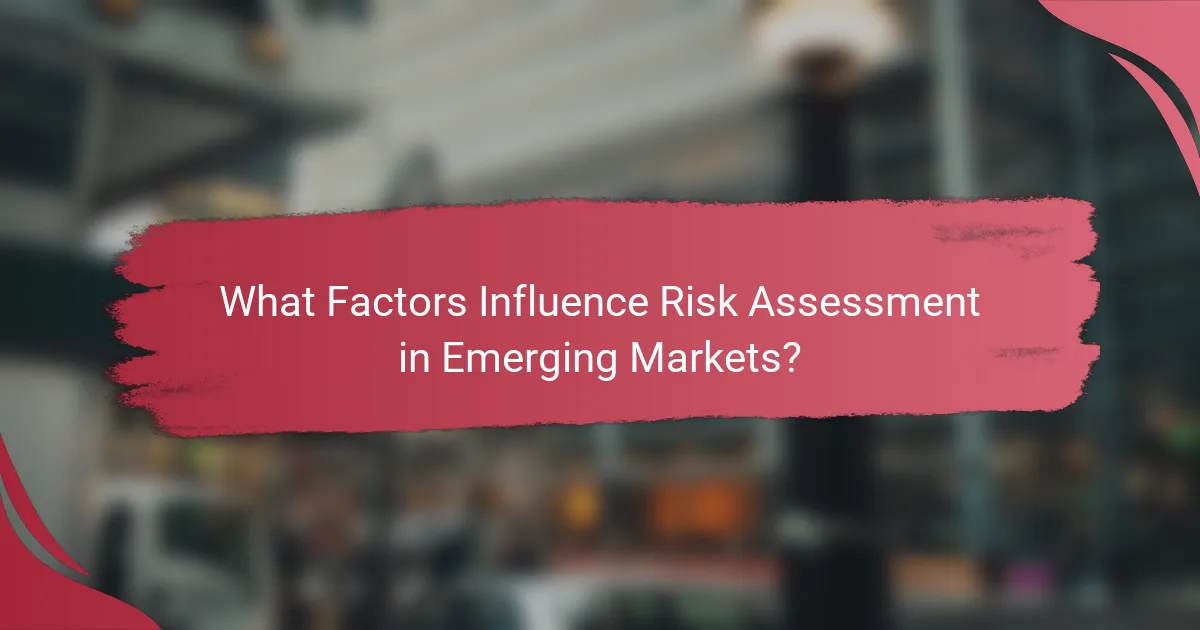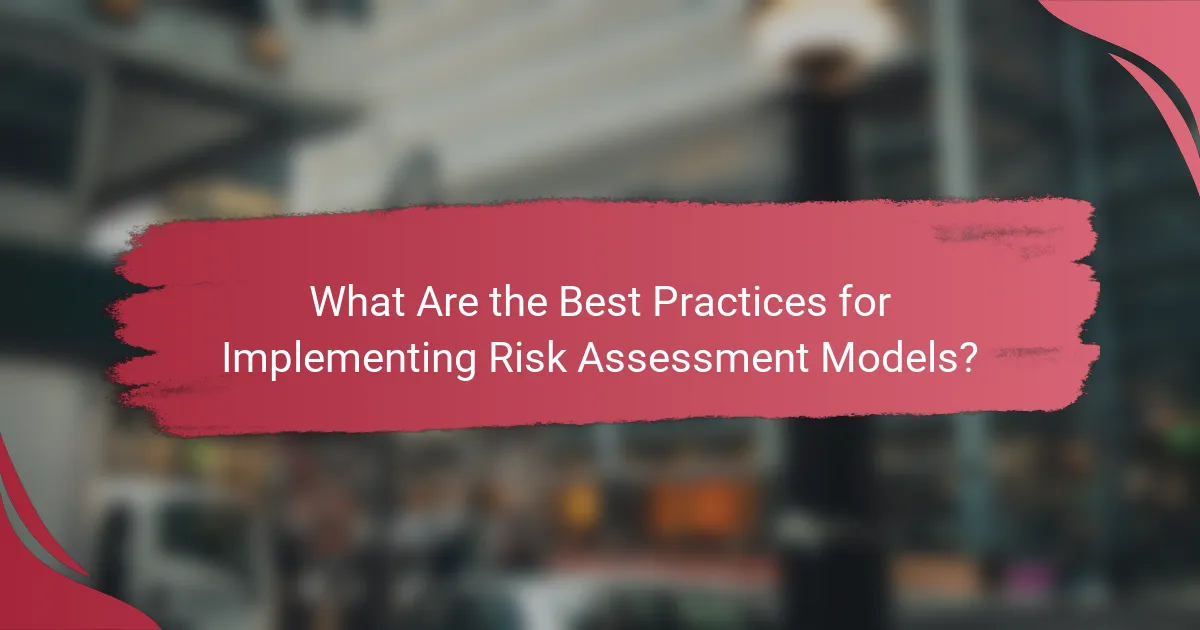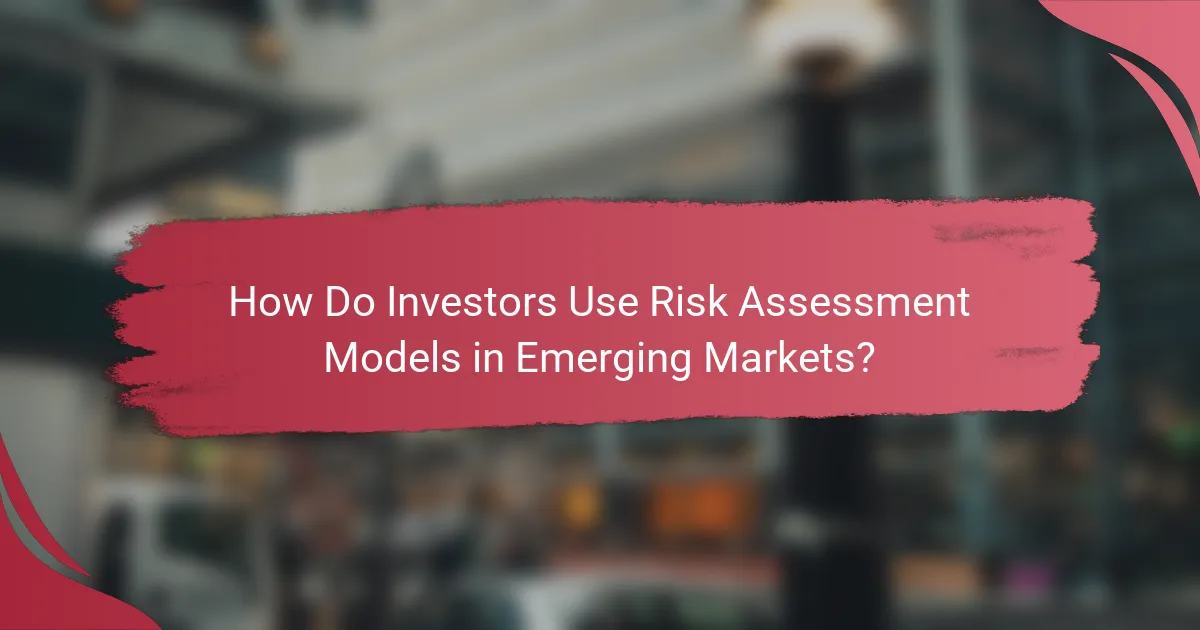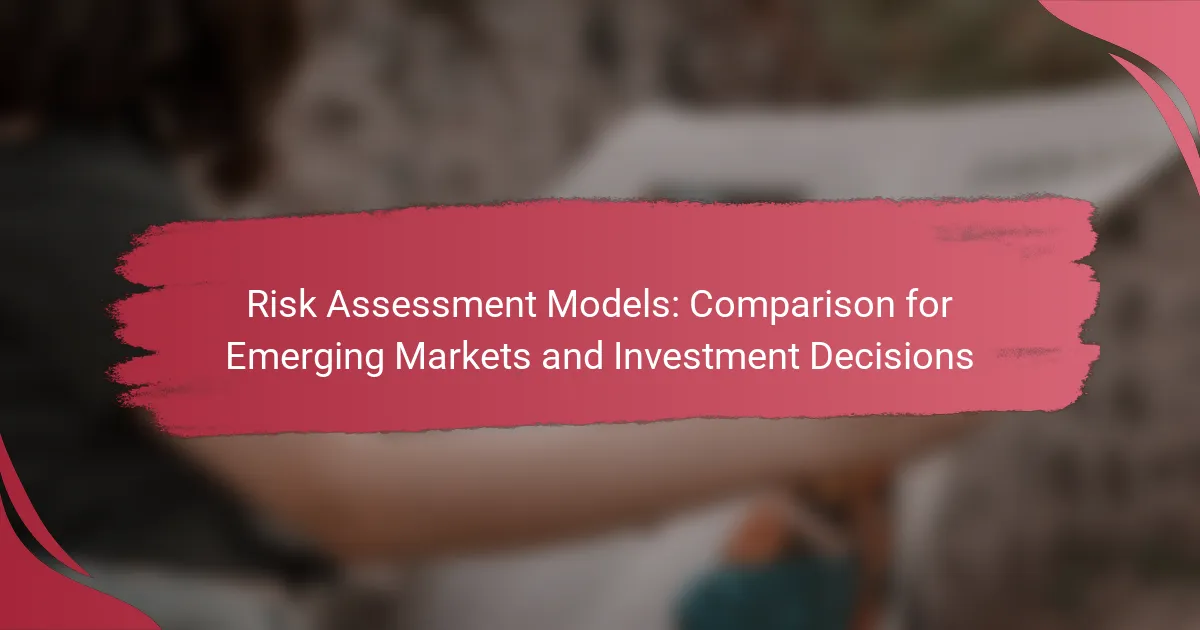Risk assessment models are crucial for investors looking to navigate the complexities of emerging markets, as they help evaluate potential returns against inherent risks. These models vary in effectiveness, influenced by factors such as political stability, economic indicators, and market liquidity, making it essential for investors to select the appropriate framework tailored to their specific needs and conditions.

What Are the Key Risk Assessment Models for Emerging Markets?
Key risk assessment models for emerging markets help investors evaluate potential returns against risks. These models provide frameworks for analyzing financial data, market conditions, and economic indicators specific to developing economies.
Capital Asset Pricing Model (CAPM)
The Capital Asset Pricing Model (CAPM) estimates the expected return on an investment based on its systematic risk, represented by beta. In emerging markets, where volatility is often higher, CAPM can help investors understand the trade-off between risk and return.
Investors should consider the market risk premium, which can vary significantly in emerging markets due to political and economic instability. A typical market risk premium might range from 5% to 10%, depending on the specific country and its economic conditions.
Discounted Cash Flow (DCF)
The Discounted Cash Flow (DCF) model calculates the present value of expected future cash flows, adjusted for risk. This method is particularly useful in emerging markets where cash flow projections can be uncertain due to fluctuating economic conditions.
When applying DCF in these markets, investors should use a higher discount rate to account for increased risk, often between 10% and 20%. Sensitivity analysis can also help gauge how changes in assumptions impact valuation.
Value at Risk (VaR)
Value at Risk (VaR) quantifies the potential loss in value of an investment over a defined period for a given confidence interval. In emerging markets, VaR can help investors understand the worst-case scenario under normal market conditions.
Commonly used confidence levels are 95% or 99%, with time horizons typically set at one day or one month. However, due to the unique risks in these markets, VaR estimates can be less reliable, necessitating a cautious approach.
Monte Carlo Simulation
Monte Carlo Simulation uses random sampling and statistical modeling to estimate the impact of risk and uncertainty on investment outcomes. This method is beneficial in emerging markets, where numerous unpredictable factors can influence returns.
By simulating thousands of potential outcomes, investors can better understand the range of possible returns and the likelihood of various scenarios. This approach allows for a more nuanced risk assessment compared to deterministic models.
Scenario Analysis
Scenario Analysis involves evaluating the effects of different hypothetical situations on investment performance. This model is particularly relevant in emerging markets, where external factors like political changes or economic crises can drastically alter outcomes.
Investors should develop multiple scenarios, including best-case, worst-case, and base-case situations. This approach helps in understanding potential risks and preparing strategies to mitigate them, making it a vital tool for decision-making in uncertain environments.

How Do These Models Compare for Investment Decisions?
Risk assessment models vary significantly in their effectiveness for investment decisions in emerging markets. Understanding these differences can help investors choose the right model based on their specific needs and market conditions.
Risk vs. Return Trade-off
The risk vs. return trade-off is a fundamental concept in investment decisions, particularly in emerging markets where volatility is common. Generally, higher potential returns come with increased risk. Investors should assess their risk tolerance and investment horizon to determine the appropriate balance.
For instance, a model that emphasizes high returns may overlook significant risks, leading to potential losses. Conversely, a conservative model may underperform in a booming market. Investors should evaluate models based on their ability to accurately reflect this trade-off.
Model Complexity
Model complexity can greatly influence the usability and effectiveness of risk assessment tools. Simple models often provide quick insights but may lack depth, while complex models can offer detailed analyses but require more expertise to interpret. Investors must consider their own knowledge and resources when selecting a model.
For example, a multi-factor model might provide a comprehensive view of risk but could overwhelm investors without a strong analytical background. A straightforward model might suffice for those seeking basic insights, especially in fast-moving markets.
Data Requirements
Data requirements differ across risk assessment models, impacting their applicability in emerging markets. Some models demand extensive historical data, which may not be readily available in less developed economies. Others may rely on real-time data, which can fluctuate significantly.
Investors should ensure they have access to reliable data sources that meet the model’s requirements. For instance, using a model that requires daily market data might be impractical in markets with limited trading activity. Understanding these data needs can help investors avoid pitfalls associated with incomplete information.
Market Sensitivity
Market sensitivity refers to how responsive a model is to changes in market conditions. In emerging markets, where economic and political factors can shift rapidly, models that are too rigid may fail to provide accurate assessments. Sensitivity to market dynamics is crucial for effective risk management.
Investors should look for models that incorporate scenario analysis and stress testing to evaluate potential impacts of market changes. For example, a model that adjusts for currency fluctuations or political instability can offer more reliable insights in volatile environments. This adaptability can be a key factor in making informed investment decisions.

What Factors Influence Risk Assessment in Emerging Markets?
Risk assessment in emerging markets is influenced by various factors, including political stability, economic indicators, market liquidity, and the regulatory environment. Understanding these elements helps investors make informed decisions and navigate potential challenges.
Political Stability
Political stability is crucial for assessing risk in emerging markets, as it directly affects investor confidence and economic performance. A stable political environment typically leads to consistent policies, while instability can result in abrupt changes that disrupt markets.
Investors should monitor political events, such as elections or government changes, that may impact stability. Countries with a history of political unrest may present higher risks, while those with established democratic processes often provide a more secure investment climate.
Economic Indicators
Economic indicators, such as GDP growth, inflation rates, and unemployment figures, play a significant role in risk assessment. Positive economic growth signals a healthy market, while high inflation or unemployment can indicate underlying issues.
Investors should analyze trends in these indicators over time. For example, a country with steady GDP growth and low inflation is generally more attractive than one experiencing economic volatility. Regularly reviewing reports from organizations like the International Monetary Fund (IMF) can provide valuable insights.
Market Liquidity
Market liquidity refers to the ease with which assets can be bought or sold without significantly affecting their price. In emerging markets, liquidity can vary widely, impacting investment decisions and risk levels.
Investors should assess the trading volume and market depth of specific assets. Low liquidity can lead to higher volatility and difficulty in executing trades. It’s advisable to focus on markets with sufficient liquidity to minimize potential losses during downturns.
Regulatory Environment
The regulatory environment in emerging markets can significantly influence risk assessment. Clear and consistent regulations promote investor confidence, while ambiguous or frequently changing rules can create uncertainty.
Investors should familiarize themselves with local laws and regulations, including taxation and foreign investment restrictions. Engaging with local legal experts can help navigate these complexities and avoid potential pitfalls that may arise from non-compliance.

What Are the Best Practices for Implementing Risk Assessment Models?
Implementing effective risk assessment models involves systematic data collection, rigorous validation, and ongoing monitoring. These best practices ensure that models remain relevant and accurate, particularly in the dynamic environments of emerging markets.
Data Collection Strategies
Effective data collection is crucial for developing robust risk assessment models. Focus on gathering high-quality, relevant data from diverse sources, including financial reports, market trends, and macroeconomic indicators. Utilizing both quantitative and qualitative data can enhance the model’s predictive power.
Consider leveraging local data sources, such as government publications or industry reports, to capture specific market nuances. In emerging markets, this might include information on regulatory changes or socio-economic factors that could impact investment decisions.
Model Validation Techniques
Model validation ensures that the risk assessment model accurately reflects reality and can reliably predict outcomes. Employ techniques such as backtesting, where historical data is used to test model predictions against actual results. This helps identify any discrepancies and refine the model accordingly.
Additionally, consider using cross-validation methods to assess model performance across different datasets. This approach can help mitigate overfitting and provide a more generalized view of the model’s effectiveness in various scenarios.
Continuous Monitoring Approaches
Continuous monitoring is essential to maintain the relevance of risk assessment models over time. Establish a routine for reviewing model assumptions and performance metrics, adjusting them as necessary based on new data or changing market conditions. This proactive approach helps identify emerging risks early.
Utilize automated tools and dashboards to track key performance indicators (KPIs) in real-time. This allows for quick adjustments to strategies based on market shifts, ensuring that investment decisions remain informed and timely.

How Do Investors Use Risk Assessment Models in Emerging Markets?
Investors utilize risk assessment models in emerging markets to evaluate potential returns against associated risks. These models help in identifying vulnerabilities and opportunities, guiding investment decisions in often volatile environments.
Portfolio Diversification
Portfolio diversification is crucial for managing risk in emerging markets. By spreading investments across various asset classes, sectors, and geographies, investors can reduce the impact of any single investment’s poor performance. For instance, combining equities from different emerging economies can balance out risks related to political instability or economic downturns.
Investors should consider allocating between 20-30% of their portfolios to emerging markets, depending on their risk tolerance. This approach not only enhances potential returns but also cushions against local market fluctuations.
Investment Timing
Effective investment timing is vital in emerging markets, where economic conditions can change rapidly. Investors often rely on risk assessment models to identify optimal entry and exit points based on market signals and economic indicators. For example, a model might suggest investing during periods of economic recovery or when valuations are particularly low.
Utilizing technical analysis alongside fundamental assessments can enhance timing decisions. Investors should monitor key indicators such as GDP growth rates, currency stability, and interest rates to make informed timing choices.
Risk Mitigation Strategies
Implementing risk mitigation strategies is essential for safeguarding investments in emerging markets. Common strategies include using hedging techniques, such as options or futures, to protect against currency fluctuations or commodity price changes. Additionally, setting stop-loss orders can limit potential losses on individual investments.
Investors should also stay informed about local regulations and economic policies that may impact their investments. Regularly reviewing and adjusting risk assessment models based on changing market conditions can further enhance risk management efforts.



